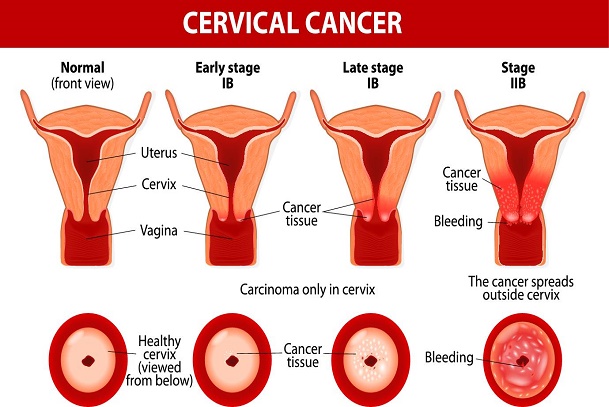 Wash your hands regularly and wear a face mask.
Learn more
Wash your hands regularly and wear a face mask.
Learn more

An Overview of Cancer of the Cervix
Cervical cancer is a type of cancer that occurs in the cells of the cervix — the lower part of the uterus that connects to the vagina. It is the term used to describe tumors that can grow at the lower end of the womb. These tumors usually develop from abnormal cell changes at the entrance to the womb from the vagina (the opening of the cervix).
The cervix (neck of the womb) is a strong, muscular tube-like structure. The very bottom end of the cervix sticks out into the vagina a little, at the opening of the cervix. The inside of the cervix is lined with a mucous membrane. Glands in the mucous membrane produce a thick liquid (cervical mucus) that acts as a barrier, preventing germs from entering the womb from the vagina. Abnormal cell changes can be detected through screening and then removed.
Cervical cancer occurs when the cells of the cervix grow abnormally and invade other tissues and organs of the body. When it is invasive, this cancer affects the deeper tissues of the cervix and may have spread to other parts of the body (metastasis), most notably the lungs, liver, bladder, vagina, and rectum.
Cervical cancer is the fourth most frequent cancer in women with an estimated 495,000 new cases in 2019 around the globe, and with the disease taking the lives of over 250,000 per year. Approximately 90% of deaths from cervical cancer occurred in low- and middle-income countries, and this high mortality rate from cervical cancer globally could be reduced through a comprehensive approach that includes prevention, early diagnosis, effective screening and treatment programmes. There are currently vaccines that protect against common cancer-causing types of human papilloma virus and can significantly reduce the risk of cervical cancer.
Most women diagnosed with precancerous changes in the cervix are in their 20s and 30s, but the average age of women when they are diagnosed with cervical cancer is the mid 50s. This difference in the age at which precancerous changes are most frequently diagnosed and the age at which cancer is diagnosed highlights the slow progression of this disease and the reason why it can be prevented if adequate steps are taken.
Cervical Cancer in Nigeria and Africa
Cervical cancer is the most common genital cancer and one of the leading causes of death among female population. Although readily detectable in its premalignant stage, cervical cancer remains the second most common cancer in Nigeria. Among the female population in Nigeria, it is the most common cancer. In 2007, it was reported that 36.59 million women aged ≥15 years in Nigeria are at risk of developing cervical cancer. There are 9922 cases diagnosed annually with 8030 deaths. Human papilloma virus (HPV) prevalence is 24.8%.
Apart from Nigeria, cervical cancer is commoner in developing countries than developed countries i.e. African countries; which has made the likes of Swaziland, Malawi leading the charts on the list of countries with high cervical cancer rates (check the table 1 below).
|
Table I – Age Standardized Incidence Rate in African Countries |
||
|
Rank |
Country |
Age – Standardized Rate Per 100,000 |
|
1 |
Swaziland |
75.3 |
|
2 |
Malawi |
72.9 |
|
3 |
Zambia |
66.4 |
|
4 |
Zimbabwe |
62.3 |
|
5 |
Tanzania |
59.1 |
|
6 |
Burundi |
57.4 |
|
7 |
Uganda |
54.8 |
|
8 |
Lesotho |
52.1 |
|
9 |
Madagascar |
51.6 |
|
10 |
Comoros |
50.9 |
|
11 |
Guinea |
45.5 |
|
12 |
Burkina Faso |
45.1 |
|
13 |
Mali |
43.9 |
|
14 |
South Africa |
43.5 |
|
15 |
Mozambique |
42.8 |
|
16 |
Senegal |
37.8 |
|
17 |
Liberia |
37.2 |
|
18 |
Angola |
36.1 |
|
19 |
Kenya |
33.8 |
|
20 |
Nigeria |
27.2 |
|
Table II – Age Standardized Incidence Rate in Selected Developed Countries |
||
|
Rank |
Country |
Age – Standardized Rate Per 100,000 |
|
1 |
UK |
9.4 |
|
2 |
Germany |
8.9 |
|
3 |
Canada |
7.4 |
|
4 |
USA |
7.3 |
Conclusion
From the overall age standardized rate per 100,000 between African countries and selected developed countries in relation to cervical cancers, the disparity shows that developed countries are getting fewer rates of cervical cancer than their African counterparts. This shows that cervical cancer is a preventable disease and effective preventive measures have been taken in developed countries. African countries should follow their examples.
[Next Week – How to Prevent Cancer of the Cervix]